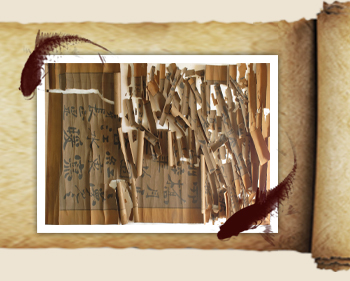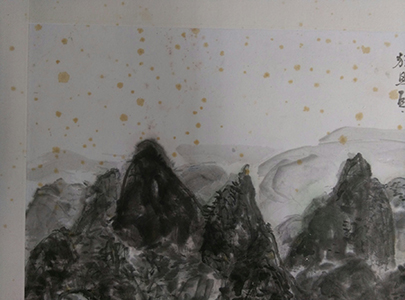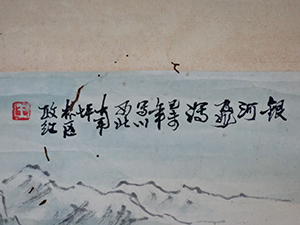

| Damage Factors | Types of Damage | Prevention Methods |
The Damage of the Ancient Calligraphy
Ancient calligraphies are very fragile antiquities. The factors of causing the ancient calligraphies to damage could be classified in two categories. The first factor is man-made destructions, and the second one is the natural factors.
3.1.1 Man-man destruction
Man-made destruction can simply be divided into two types. The first belongs to wars and incineration destruction. Another is the destruction during the period of construction and also by tourists.
3.1.2. Natural Factors
Natural factors of the damage of ancient calligraphies can also be divided into two types. The first type of damage is by natural disasters, including the earthquakes, floods, and lightning. The effect of those natural disasters cannot be estimated. On the other hand, the other kind of damage is purely physics, for examples, biological effects, exposure to light, microorganisms, moisture, and also temperature. Whether the former or the latter will bring a great impact on the value to the ancient calligraphies. Source : Website Bing
3-2 Types of Damages TOP The damage of the ancient calligraphies can be roughly classified into the following five ways:
3.2.1 Damage by Temperature and Humidity
IIn a typical environment, if the temperature is too low, it will cause the works to contract. Oppositely, if the temperature is too high, it will cause the works to expand. When the works constantly go through the effect of thermal expansion, overtime, the ancient calligraphies will eventually crack. Furthermore, if the humidity is too high, it will also cause the writings of the ancient calligraphies to smudge. In addition, improper temperature and humidity may also produce bacteria or microbes. Therefore, the controlling of the humidity and the temperature of the ancient calligraphies is important, and cannot be ignored.
3.2.2 Damage by Ultraviolet Light
There are a total of three aspects that the quality of the ancient calligraphies will be affected by light, optical radiation of heat, light oxidation, and light damage. The ultraviolet light will cause the surface of the ancient calligraphies to fade, and will also affect the durability of the materials of the works. If the ancient calligraphies are exposed to the light for a long time, the light may cause the original color of the ancient calligraphies to change colors.
Source : Website Bing 3.2.3 Damage by Air Pollution
Since the air pollution is acidic, it may change the quality of the paper to and eventually make the ancient calligraphies to become more brittle. Sulfurous acid gas, hydrogen sulfide, ammonium hydroxide, chlorine, and ozone are all examples of acidic air pollution. Therefore, to prevent the ancient calligraphies to suffer from the effect of air pollution, it is better to keep the studio's away from the chemical factories that emit lots of dirty air pollution.
3.2.4 Damage by Dust and Microorganisms
When people clean up the dust on the ancient calligraphies, it is very likely that they will scratch the surface of the calligraphies. However, if the dust is not cleaned up, the dust will eventually damage the quality of the ancient calligraphies, and later produce mold.
Source : Website Bing 3.2.5 Damage by Pests
The major materials that made the ancient calligraphies are paper and silk. In addition, both of the materials are mostly organic, and which they provide an excellent source of food to the pests. Furthermore, paper's carbohydrate is also one of the foods that pests like to eat. Common pests that eat ancient calligraphies are silverfish, cockroaches, beetles, termites, and rats. The saliva, excrement, dead bodies of the pests will also pollute the materials and qualities of the ancient calligraphies.
Source : Website Bing
3-3 Prevention Methods for the Damaging of Ancient Calligraphies TOP To preserve the ancient calligraphies, we shall be aware of the following situations:
3.3.1 The Controlling of the Humidity and the Temperature
In order to preserve the ancient calligraphy, first of all we have to have a certain temperature and humidity. Generally, major ancient calligraphies materials are made of paper, silk, damask, and brocade. Usually, the temperature is 15 ℃ to 18 ℃ and the most favorable humidity is often 55% to 65% for the preservation of ancient calligraphy. Secondly, we have to prevent the ancient calligraphies from rodents and insects, as well as to prevent moisture and mold. The best way is to place the ancient calligraphies in the cabinets, and the cabinets should be stored in a dry place. In addition, we should have annual check-ups of the cabinets. It is best to choose a sunny and dry weather to dry the ancient calligraphies. The purpose of doing this is to emit humidity in the ancient calligraphies. Be careful not to put the calligraphies directly towards the sun, otherwise they will tilt. On the other hand, by putting the ancient calligraphies into the cabinets, the cabinets will provide stable temperature and stable the humidity of the calligraphies. Furthermore, it will also prevent the oxidation and aging of the calligraphies and can effectively prevent insects and the occurrence of mold.
3.3.2 The Importance of Cleaning Up the Dust and the Long Time Expose of the Ancient Calligraphies
Third, we must correctly handle the dirt of the ancient calligraphies; some people will use a piece of clothing or a brush to wipe the dust on the ancient calligraphies. This approach will damage the surface of the ancient calligraphies because usually the surfaces of the clothing or brushes are hard. The correct way is to spread the ancient calligraphies on a flat table and wipe them gently with a feather broom but, if the dust is not clean off, then you can decide to use a long, soft hair brush. Fourth, we cannot hang the ancient calligraphies on the wall. The reason is because that long-term exposure will cause ancient calligraphies to erode because of the wind. If you exposed the ancient calligraphies outside for a long time, the paper qualities of the ancient calligraphies will start to decrease. This would also make the ancient calligraphies brittle. In addition, the whole picture will lose the original color. There are two kinds of ways to store ancient calligraphies that are without frames. The first way is to roll the ancient calligraphies together. The second way is to unfold the ancient calligraphies. To solve this problem, we could frame the ancient calligraphies, and surrounded them by silk, so you can avoid the problem of ancient calligraphies being erode by wind and dust on the surface.
3.3.3 Affectation of Lights
Finally, the greatest impact of destroying the ancient calligraphies on the natural factor is the ultraviolet light. It can also lead to color transformation, decomposition, and also paper change. Ultraviolet is mainly from the sunlight. Moreover, incandescent light bulbs and fluorescent tubes also emit a small amount of ultraviolet. Therefore, when people are hanging the ancient calligraphies up, remember that you can not hang them close to the windows. The purpose for that is to avoid sunlight. Fluorescent bulbs will emit 400-700nm, although it only affects a little, but it will turn the ancient calligraphy yellow. Therefore, in the house layout arrangement, we should keep light bulbs and fluorescent lamps to more than one meter, and use a low-power light source.
Reference:













